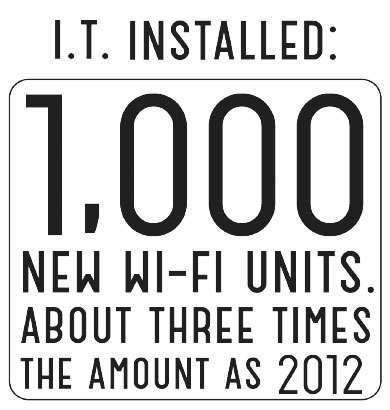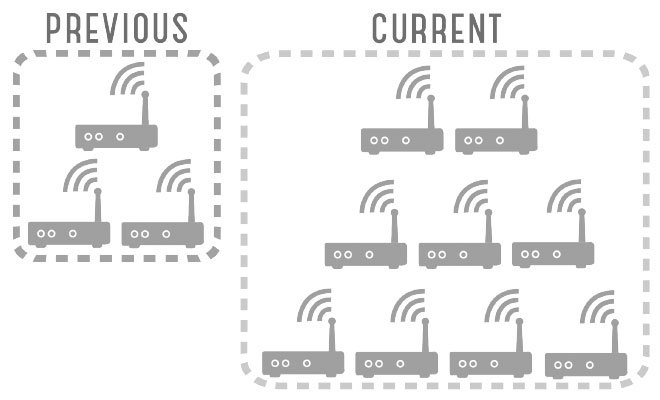Technology on campus may have improved significantly in recent months, if all of the Office of Information Technology’s emailed updates are to be believed, but students are still annoyed by their regular inability to access basic and essential features like printing and campus Wi-Fi.
“What we hear is that too often the printers don’t work,” said Chief Information Officer and Vice President for Information Technology Chuck Porter. “And by that I mean that they’re broken, they’re out of toner, and they need maintenance.”
Between students, faculty and staff, OIT supports a lot of printing.
“OIT reports we print about 13 ½ million pages a year. If you laid those end to end they would reach here to Detroit. If you stacked them up they’d be three Space Needles plus two Columbia Towers plus an Empire state building. If you weighed them they’d weigh the same as a 737 [aircraft],” Porter said.
Library Desk Assistant David Strand has to hear all about printer and VLab problems at the library.
“My job is then to call Library Tech Support, and they usually handle all those issues and work in conjunction with OIT,” said Strand.
Last week, a few whiteboards in the library said that all printers on campus were down, but that doesn’t appear to have been the case.
“We only had one printer server that was down for about 45 minutes and the printers in the library were offline,” Porter said. “We rebooted the server and everything was back to normal. Whoever wrote that believed it to be true, but it wasn’t, in fact, true.”
Eric Sype, a student employee at the Circulation Desk, argues that some sort of improvement is urgently needed.
“The printers are constantly jammed or the computers are not connecting to them correctly,” Sype said. “Then people cannot print their papers, they are late to class, they are turning in their papers late, and various bad things happen.”
Plagued with recurring malfunctions, some students have decided to buy their way out of the system.
“I’ve had a lot of problems in the past with printing,” said senior Brian Clawson. “The machine broke down or was being fixed so many times that I eventually bought my own printer because I couldn’t handle it anymore.”
These sort of problems, as well as jamming and connectivity, are because of the printers themselves. The devices need to be upgraded for many reasons. On campus the printers available are all single-functioning, meaning each individual machine is only able to perform one task, be it printing in black and white, printing in color, faxing or scanning. OIT hopes to convert to multipurpose printers that can perform all of these functions.
“What we are working on right now is a managed print services upgrade for campus. What we want to do is upgrade our entire print infrastructure,” Porter said.
The print infrastructure upgrade is intended to reduce the amount of printers on campus, have them more practically located, and ensure each device is multipurpose functioning. Ideally, rather than printing to a specific printer, you can select “Print” from your phone, tablet, laptop, desktop or lab. Once you reach whatever happens to be the closest printer you can scan your student ID card and print your document.
These sorts of devices will even send for maintenance when needed.
“They are smart enough to phone home if they need maintenance,” Porter said. “They can literally send an email to a manage-print vendor and say ‘I need maintenance’.”
Porter met with the President’s cabinet to discuss these plans on Oct. 21, gaining their support and approval to receive bids for printers from vendors. These printers range in price from $4,000 to $20,000, depending on capacity and features.
As noted above, connectivity to the VLab system has also been a problem for several students. Strand acknowledged a plethora of complaints over this issue, but did express his belief that while the system may not be perfect, it appears to him that all those involved are working as quickly as possible to correct glitches.
Although new printers may be years away, and VLab doesn’t look as though it’s going anywhere, Wi-Fi has been a major project for OIT in recent weeks, especially as they completed a network upgrade over the summer.
OIT listed their upgrades in an email, including 1,000 new Wi-Fi hotspots (tripling the amount from last year), 65 miles of fiber optic cable has been installed for wired and wireless access, bandwidth has been upgraded from 1Gb/sec to 2Gb/sec, and wireless coverage now spans 1.8 million sq. feet.
This is all good news, except for those who live in the Douglas.
“The Douglas is a problem,” Porter said. “We had planned to put upgraded Wi-Fi in the Douglas and the owners of that building asked us not to. Since we don’t own the building there was nothing we could do.”
OIT does recognize the shortcomings of their network upgrade and current printing system, and the team says they are working hard to repaire the system’s failures.















